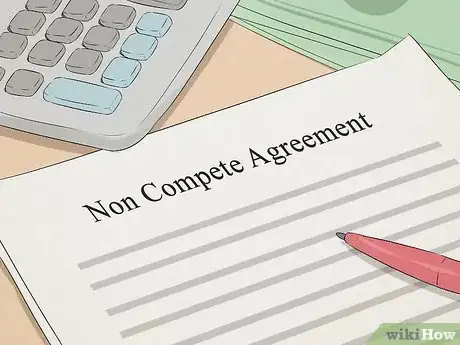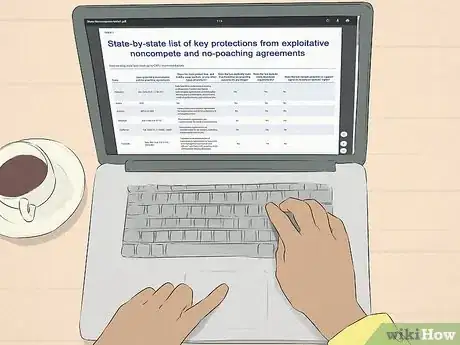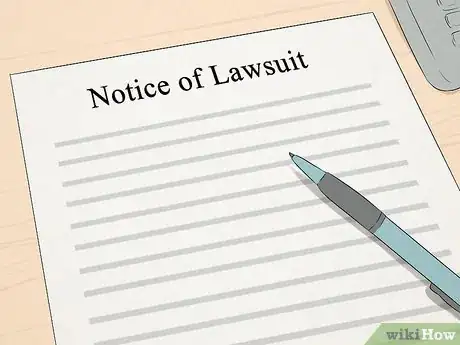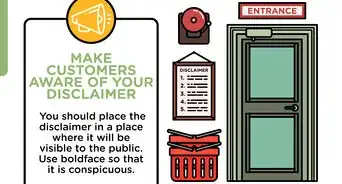This article was written by Jennifer Mueller, JD. Jennifer Mueller is an in-house legal expert at wikiHow. Jennifer reviews, fact-checks, and evaluates wikiHow's legal content to ensure thoroughness and accuracy. She received her JD from Indiana University Maurer School of Law in 2006.
There are 13 references cited in this article, which can be found at the bottom of the page.
This article has been viewed 341,996 times.
When you were hired, you may have been asked to sign a non-compete agreement. This agreement prohibits you from working with competing firms in the same business or industry after you leave your current employer, for a specified period of time and in a certain geographic area.[1] When you signed the agreement, you might not have thought much about it. After all, you recently started a new job – you probably weren't thinking about leaving just yet. However, when you do decide it's time to move on, a non-compete agreement can seriously limit your options in finding a new position. For this reason, many states have tough laws that restrict the scope of non-compete agreements, and judges are reluctant to enforce them – which makes it less difficult for you to get out of a non-compete agreement you signed.[2] [3]
Steps
Asking for Release
-
1Get a copy of the agreement you signed. Closely reading the non-compete agreement you signed can give you a better idea of the interests the company seeks to protect and what you need to stress in asking for a release.
- Make sure that you actually signed the agreement, and that a corporate representative with power to bind the company also signed the agreement. Without the signature of both parties, a contract such as a non-compete agreement is not binding on either party.[4]
- If the non-compete agreement in your HR file wasn't signed (either by you, by a corporate representative, or both), a court won't enforce it.[5] This can give you great leverage in negotiations to get a release from the agreement, because essentially there is no agreement.
- Assuming the agreement was properly signed, next study the provisions detailing your former employer's responsibilities. If any of those things didn't happen, or if they changed, the agreement is likely no longer enforceable. The same holds true for any designations of your employment or your role in the company.[6]
- For example, if you signed a non-compete agreement when you were a sales representative, but you are now a sales manager, that original non-compete agreement may be unenforceable – unless you signed a new agreement for your manager position. Put simply, although the agreement bound you as a sales representative, it may not bind you as a sales manager.
- The key for courts is whether your employment relationship changed. Any change of job duties, authority, or compensation may invalidate your old agreement.[7]
- You also should carefully read the scope of the agreement. The job you want to take may not, in fact, violate the non-compete agreement. For example, if you have a non-compete agreement that prohibits you from working for another company that uses "the same or similar technology" as your old employer, and the new employer actually uses different technology, the non-compete agreement probably doesn't cover your new job – even if the two companies provide similar services or are involved in the same industry.[8]
-
2Consider what your job at the company entailed. Non-compete agreements exist to protect trade secrets and other confidential information, or to protect business relations. The company has you sign a non-compete agreement because they're worried you'll take their clients to your new company, or use the trade secrets you learned and use them to benefit the new company. However, if you didn't have any direct relations with clients, and didn't learn any trade secrets, the non-compete agreement probably isn't enforceable against you.[9]
- For example, some companies just require every employee to sign a non-compete agreement, regardless of their role in the company. If you were hired as a receptionist for one company, and you've now been offered a position as an executive assistant in another company, it is unlikely you have any trade secrets or client relationships that you could take to the new company.
- A non-compete agreement, like any other contract, must be supported by valid consideration. This means your employer must have provided you with some additional benefit or compensation in return for your signature on the non-compete agreement. If you weren't provided any additional benefits, or if you were promised a bonus or other compensation that you never received, that would invalidate the agreement.[10] [11]
- In some situations, simply making your continued employment contingent on your signing of the non-compete agreement constitutes valid consideration. This could be the case if, for example, your employment was categorized as "at-will" employment, and you didn't sign any other employment contract stating otherwise.[12]
Advertisement -
3Review your state's law. Some states have passed tough laws regarding the enforcement and legality of non-compete agreements. It may be that your agreement was signed before such a law went into effect, and hasn't been updated to comport with the law. Check your local legislature’s website or view an overview of state laws like this one from the Center for American Progress: https://cdn.americanprogress.org/content/uploads/2019/04/02054652/State-Noncompetes-table1.pdf
- Some states, such as California and North Dakota, no longer permit non-compete agreements regardless of the terms of the agreement.[13] If you live and work in one of those states, the agreement is legally unenforceable.
- Other states have placed legal limits on the specific rights or legitimate business interests an employer can seek to protect through a non-compete agreement.[14] For example, a non-compete agreement is only allowed in Washington to protect customer information and contacts or a company's goodwill, such as particular relationships with customers.[15]
- In some states, such as Tennessee and Texas, non-compete agreements are permitted but physicians are exempt from them. A few states exempt some other employees, such as nurses and broadcasters.[16] Attorneys are exempt from non-competes in all 50 states under the ABA's Rules of Professional Conduct.[17]
-
4Organize your information. Outline all your points and issues so you're prepared to have an objective discussion about being released from your agreement.
- If you've found defenses you could use in court to defeat the agreement, you should present these points to your employer up front. The company already faces an uphill battle to enforce the non-compete agreement, since judges don't like to enforce an agreement that hinders your ability to procure gainful employment. If you can demonstrate that you would win at trial, the company may be more willing to negotiate with you ahead of time and spare the expense of trial.[18] [19]
-
5Schedule a sit-down meeting. You should sit down face to face with someone such as your manager or a human resources representative who has the power to release you from your agreement.
- Open your meeting by focusing on what you want, using the outlines you've made and the research you've done.
- Go through your defenses, and stress your desire to leave on good terms. If you're willing to concede on some points, you may be able to come to a compromise that would enable you to take your new job. For example, if you previously worked as a sales representative, and the company is worried that you will lure clients to your new firm, you might be willing to sign an agreement in which you were allowed to work at the competing firm if you agreed not to have any communication with any of the company's clients.
-
6Negotiate the terms of your release. It may be possible to craft a new agreement that both protects the company's interests and allows you to take the new job you want.
- When negotiating, pay attention to the length of time the agreement's prohibitions are in effect, the geographical boundaries it covers, and the activities it prohibits. The scope of these terms is the primary focus of legal arguments, and a court will strike down or limit unreasonable terms.[20]
- Since you already have a new offer, limiting the amount of time the agreement applies likely won't help you much. For example, if the agreement prohibits you from engaging in competing activities with another company for 10 years, cutting it down to 5 years still won't mean you aren't violating the agreement when you take your new job.
- In certain circumstances, you may be able to use geography to carve out an exception for your new job. For example, suppose your current employer operates solely in Tennessee, and you have a job offer in California. Your non-compete agreement prohibits you from working for a competing firm anywhere in North America – but on a practical level, the company in California can't be considered to compete with a company whose business doesn't extend outside of Tennessee. In that situation, you might be able to get your employer to settle for a new agreement that prohibited you from working for a competitor in Tennessee. Since you're moving to California, this probably isn't an issue for you.
-
7Get any agreement in writing. Since your original non-compete agreement was in writing, any amendment to or release from that agreement must also be in writing.[21]
- You also should make sure that the agreement is signed both by you and an employee of the company who has the power to bind the company in that instance (such as an executive or a hiring manager), and that the original non-compete agreement is referenced and addressed.
Going to Court
-
1Receive notice of the lawsuit against you. If you decide to ignore the non-compete agreement, your former employer may sue you.
- Typically, the only way to fight a non-compete agreement is to go to court. If you are an employee (or former employee) who signed such an agreement, this means you must violate the agreement and wait to be sued.
- It may be that your former employer has never sued another employee to enforce the non-compete agreement. However, keep in mind that each employee's circumstances are different, and the reasons the company chose not to sue other employees may not apply to your situation. The fact that your former employer hasn't sued other employees in the past isn't a legally valid reason to simply ignore the agreement.[22]
- Usually the employer will be requesting a temporary injunction against you. This is a court order forbidding you from working until the final trial. You will have to go to a hearing before a judge will issue this order.[23]
- In many cases the hearing on the temporary restraining order will be the only trial in the matter, because if the judge upholds the non-compete agreement you will be forced out of work and must find a new job that doesn't violate the agreement.[24]
-
2Consider hiring an attorney. An employment attorney experienced in fighting non-compete agreements may be best able to protect your interests.
- A local attorney also will have a solid understanding of the judges in your area and the development of the law in your state. The attorney can use their knowledge of a judge's reputation to your advantage in fighting your case.
- This is particularly important when dealing with a non-compete agreement, since so much of the outcome of the case depends on what the judge considers reasonable in terms of the restrictions the non-compete agreement imposes on you.[25]
-
3File your answer to your former employer's complaint. If you are sued, you must file an answer to the lawsuit, typically within 20 days.
- The complaint states the allegations your former employer is making against you, and why it feels it is entitled to relief from the court. In your answer, you address each of those allegations and tell the court whether you admit, deny, or don't have sufficient knowledge of the allegation to either admit or deny it.[26]
- The answer is your opportunity to tell your side of the story, as well as to raise any affirmative defenses or counterclaims that have relevance to your case.[27] For example, if through your research you learned that the non-compete agreement you signed was not supported by valid consideration, you could raise that point as an affirmative defense.[28]
-
4Participate in discovery. During the discovery process, you have the opportunity to exchange information with your former employer as you build your case.
- As a part of discovery, you have the ability to ask your former employer written questions which must be answered under oath, or request documents such as human resources records be made available to you.[29]
- One important piece of information you may be able to find out through discovery is whether your former employer has sued any other employees for violation of the non-compete agreement, and what the outcome of any such lawsuits was. If prior employees have defeated the non-compete agreement and the agreement wasn't changed, you may be able to defeat it using the same arguments and principles.[30]
- Depending on whether your former employer has requested the court grant a temporary restraining order prohibiting you from violating the agreement, you may have a limited time to obtain information through discovery.
-
5Prepare your case. You can review previous cases decided in your state to analyze what judges have considered reasonable and what types of non-compete agreements judges in your state have refused to enforce.
- Reviewing your state's law as well as prior decisions from courts in your state can give you a good idea of which of your defenses are most likely to succeed.
- As part of your preparation, analyze the non-compete agreement you signed to determine if it meets the legal requirements set forth by your state's law.[31]
-
6Consider mediation. A neutral third-party may be able to help you and your former employer come to a settlement that allows you to pursue new opportunities without damaging your former employer's business.
- Mediation allows both you and your former employer to have some control over the outcome of the case, which isn't possible if the case is presented before a judge.[32]
- Additionally, mediation proceeds are confidential, which means your employer won't have to worry about the dispute over your non-compete agreement being a part of the public record.[33]
Organizing Coworkers
-
1Consider forming a union. The employees can form or join a union if the association can't convince the employer to eliminate their non-competes.
- The non-competes of the editorial staff at Law360 were recently eliminated concurrent with union organizing. There, a non-compete triggered a vote by the editorial staff to join an established union, though the non-competes were eliminated through a settlement between Law360 and the New York Attorney General a few weeks before the unionization vote.[34]
- Unions generally don't allow non-competes in their contracts with employers.
-
2Negotiate jointly. Employees can jointly negotiate to eliminate their non-competes under the protection of the National Labor Relations Act (NLRA).
- Using a new approach, 2 or more non-supervisory employees with a “community of interest” can form a "pop-up employee association" to jointly negotiate with their employer to eliminate their non-competes under the protection of the NLRA.
- Examples of small groups of employees that have met the "community of interest" standard include 30 cosmetics counter workers at a single Macy's store, and employees at a single mobile phone retail store.
Our Most Loved Articles & Quizzes
References
- ↑ https://www.workplacefairness.org/non-compete-agreements#18
- ↑ http://www.bizfilings.com/toolkit/news/startup/how-to-get-out-of-a-non-compete-agreement.aspx
- ↑ http://employment.findlaw.com/hiring-process/non-competition-agreements-overview.html
- ↑ http://www.hreonline.com/HRE/view/story.jhtml?id=534358079
- ↑ http://www.hreonline.com/HRE/view/story.jhtml?id=534358079
- ↑ http://www.hreonline.com/HRE/view/story.jhtml?id=534358079
- ↑ http://www.hreonline.com/HRE/view/story.jhtml?id=534358079
- ↑ http://skloverworkingwisdom.com/blog/how-to-defeat-a-non-compete-ten-effective-defenses/
- ↑ http://skloverworkingwisdom.com/blog/how-to-defeat-a-non-compete-ten-effective-defenses/
- ↑ https://www.workplacefairness.org/non-compete-agreements#18
- ↑ http://skloverworkingwisdom.com/blog/how-to-defeat-a-non-compete-ten-effective-defenses/
- ↑ https://www.workplacefairness.org/non-compete-agreements#18
- ↑ http://www.beckreedriden.com/wp-content/uploads/2012/09/Noncompetes-50-State-Survey-Chart-20130814.pdf
- ↑ https://www.americanbar.org/groups/litigation/committees/business-torts-unfair-competition/practice/2016/noncompete-agreements/
- ↑ http://www.beckreedriden.com/wp-content/uploads/2012/09/Noncompetes-50-State-Survey-Chart-20130814.pdf
- ↑ http://www.beckreedriden.com/wp-content/uploads/2012/09/Noncompetes-50-State-Survey-Chart-20130814.pdf
- ↑ https://www.americanbar.org/content/dam/aba/administrative/professional_responsibility/mrpc_5_6.authcheckdam.pdf
- ↑ http://skloverworkingwisdom.com/blog/how-to-defeat-a-non-compete-ten-effective-defenses/
- ↑ https://www.workplacefairness.org/non-compete-agreements#18
- ↑ http://skloverworkingwisdom.com/blog/how-to-defeat-a-non-compete-ten-effective-defenses/
- ↑ https://www.workplacefairness.org/non-compete-agreements#18
- ↑ https://www.workplacefairness.org/non-compete-agreements#18
- ↑ https://www.workplacefairness.org/non-compete-agreements#18
- ↑ https://www.workplacefairness.org/non-compete-agreements#18
- ↑ https://www.workplacefairness.org/non-compete-agreements#18
- ↑ http://nationalparalegal.edu/public_documents/courseware_asp_files/researchLitigation/PreTrialPractice/Summons.asp
- ↑ http://nationalparalegal.edu/public_documents/courseware_asp_files/researchLitigation/PreTrialPractice/Summons.asp
- ↑ http://thekuhnlawfirm.com/affirmative-defenses-minn-r-civ-p-8-03-pleading-affirmative-defenses-in-minnesota/
- ↑ http://www.nolo.com/legal-encyclopedia/formal-discovery-gathering-evidence-lawsuit-29764.html
- ↑ http://skloverworkingwisdom.com/blog/how-to-defeat-a-non-compete-ten-effective-defenses/
- ↑ http://employment.findlaw.com/hiring-process/non-competition-agreements-overview.html
- ↑ http://rothadr.com/pages/publications/Ten%20Suggestions%20for%20Negotiation%20in%20Employment%20Mediation.pdf
- ↑ http://rothadr.com/pages/publications/Ten%20Suggestions%20for%20Negotiation%20in%20Employment%20Mediation.pdf
- ↑ https://www.bna.com/law360-editorial-staff-n73014446824/
About This Article
To get out of a non-compete agreement, start by getting a copy of the agreement you signed to make sure that it’s binding. For example, if it was never signed by both yourself and by a corporate representative, a court won’t enforce it. In addition to checking for signatures, carefully read the scope of the agreement to see exactly what it entails since the language is often vague or misleading. For instance, if the agreement prohibits you from working for another company that uses “the same or similar technology,” the agreement wouldn’t cover a new job that uses different technology. If you can’t find your original agreement or if it all seems binding, check your state’s laws since many areas, like California, no longer permit non-compete agreements. For more tips from our Legal Co-Author, including how to go to court over your non-compete agreement, keep reading!












































































